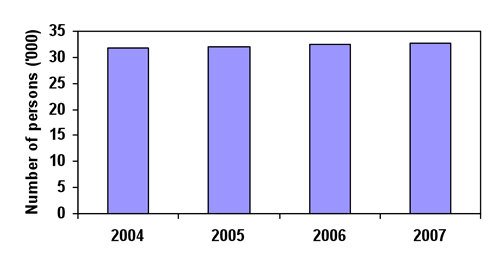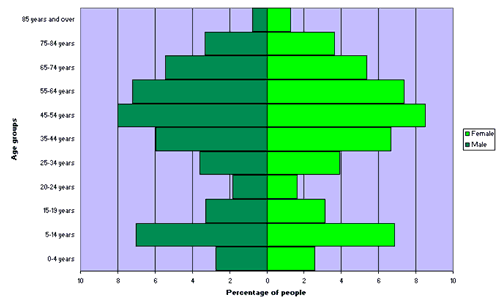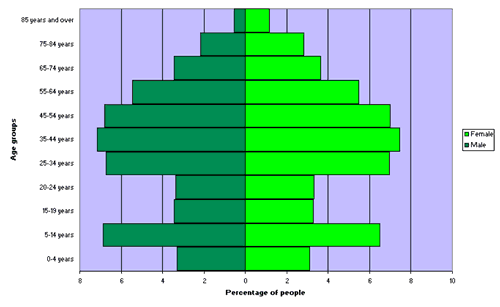Bega Valley
Indicator: Population
Results for this indicator are also available for [an error occurred while processing this directive]
What the results tell us for Bega Valley
Bega Valley Shire population continued to grow but at a reduced rate compared to the previous reporting period. According to the Census of 2006 there were 32,429 residents in the Shire, while at 30 June 2007 the estimated residential population was 32,655. Since the end of the previous State of the Environment reporting period (30 June 2004), the population of the Shire is estimated to have increased by 2.9% up to 2007, or 5% since the 2001 Census (using the 2007 estimate).
Compared with New South Wales as a whole, the Shire has a higher aged population, relatively high Indigenous population and a small proportion of people from culturally diverse backgrounds. With the Shire being made up of several small communities scattered over a large area, another key issue is that of transport.
Significant cultural and social issues have been identified in documents such as the Council’s Social Plan, Community Profile, Cultural Plan and Crime Prevention Plan. These documents provide a framework for developing one year plans to enable the delivery of 5 year strategies. The current Social Plan was developed through extensive consultation with a wide range of stakeholders including the Council’s Social Planning Committee.
Population is growing in number and age
The population in Bega Valley Shire was 32,429 at the 2006 Census (Table 1). Compared to the figures stated in the 2004 State of the Environment Report the annual average rate of growth has dropped from 3% to 1% per annum for the years 2004 to 2007 which is slightly above the 0.7% average for the Australian Capital Region for the period, and 0.8% for New South Wales as a whole. Compared with all local government areas across the state, this represents a ranking of 62 out of 149 for the fastest growth and 68 out of 152 for the largest growth. Figure 1 illustrates the growth for the years 2004 to 2007, showing the annual estimated residential population at 30 June for each year.
| 2004 | 2005 | 2006 | 2007 | Population Change2004-2007 |
|---|---|---|---|---|
| 31,763 | 32,071 | 32,429 | 32,655 | 892 (1% p.a.) |
See About the data for Australian Bureau of Statistics comments on years 2001-2007; Source: Australian Bureau of Statistics Catalogue No. 3218.0 (2008)
Figure 1. Population growth, Bega Valley Shire, 2004 to 2007

Source: Australian Bureau of Statistics Catalogue No. 3218.0 (2008)
The growth in population needs to be seen in the context of the age group where most growth is occurring. On the whole, the median age is steadily increasing across the population in the Shire— in 2006 it was 45 years compared with 42 years in 2001 and 39 years in 1996. The median ages for New South Wales as a whole were 37, 35 and 34 years respectively.
Between 1996 and 2006, the percentage of people over 64 years of age has increased by 1.8% and those in the 15 to 64 age group by 2%. This is similar to the pattern stated in the 2004 report; increases were 2.2% and 1% respectively. It was a different story for the under-15 age group where there was a drop of 3.8% from 1996 to 2006, and only 2% over the earlier period. In other words, there has been an accelerating decline in the proportion of under 15’s over the 20 year period from 26% of the population in 1996 down to just over 19% in 2006. The Shire’s percentages and figures for the period 1996 to 2006 are illustrated in Table 2.
Generally, the trends for New South Wales are very similar but less dramatic than for Bega Valley. Interestingly, the under 15’s (at 21.4%) were a smaller proportion of the population in 1996 but the age group has declined at a much slower rate than has been the case in Bega. They represented 20.7% in 2001 and 19.8% in 2006. For Bega we see 23%, 21.2% and 19.2% respectively.
The Council’s Social Plan addresses social issues and target groups within the community guided by recommendations by the Social Planning Committee.
| Age | 1996 | 2001 | 2006 | |||
|---|---|---|---|---|---|---|
| No. | % | No. | % | No. | % | |
| <15 years | 6,620 | 23 | 6,461 | 21.2 | 6,063 | 19.2 |
| 15–64 years | 17,096 | 59 | 18,374 | 60.2 | 19,335 | 61 |
| 65+ years | 5,129 | 18 | 5,689 | 18.6 | 6,260 | 19.8 |
| Totals | 28,845 | 100 | 30,524 | 100 | 31,658 | 100 |
Source: Australian Bureau of Statistics Census 2006 Time Series Profile Catalogue No. 2003.0
Ethnicity and diversity
Gender
The population of Bega Valley Shire was 49.1% males and 50.9% females (2006 Census). This is almost identical to the male/female split for New South Wales (at 49.3% and 50.7%). See Figures 2 and 3 for a comparison of the gender and age distribution for Bega and New South Wales respectively.
Figure 2. Age and sex distribution, Bega Valley Shire, 2006

Source: Australian Bureau of Statistics Census 2006 Time Series Profile Catalogue No. 2003.0
Figure 3. Age and sex distribution, New South Wales, 2006

Source: Australian Bureau of Statistics Census 2006 Time Series Profile Catalogue No. 2003.0
Origins
In 2006 85.7% of Bega Valley Shire’s non-Indigenous residents were born in Australia, compared with 86.4% in 2001 (Table 3). The 810 people who identified as being of Indigenous origin in the Shire in the 2006 Census represents 2.6% of the total Shire population – an increase of 0.5% since 2001. This proportion is 0.4% higher than for New South Wales as a whole. There has been a slight increase in the number of Bega’s residents born overseas. The rate of increase is very similar to that of the Indigenous population.
| Origin | 1996 Census | 2001 Census | 2006 Census | |||
|---|---|---|---|---|---|---|
| Indigenous persons | 517 | 1.8% | 617 | 2.1% | 810 | 2.6% |
| Born in Australia | 24,507 | 86.9% | 25,322 | 86.4% | 26,356 | 85.7% |
| Born overseas (a) | 3,169 | 11.2% | 3,384 | 11.5% | 3,601 | 11.7% |
| Total | 28,193 | 100% | 29,323 | 100% | 30,767 | 100% |
(a) Includes 'Australian External Territories', 'Inadequately described', 'At sea' and 'Not elsewhere classified'; Source: Australian Bureau of Statistics Census 2006 Time Series Profile Catalogue No. 2003.0
Households and family type
In 2006, approximately 68% of Shire residents lived in one-family households consisting of about 26% couples with children, just under 32% couples with no children and almost 10% one-parent families. About 24% of the population consisted of lone person households. (Table 4). The group with the most significant percentage drop was the ‘couples with children’ group, having fallen by nearly 5% since the 1996 Census whereas the percentage of households occupied by ‘couples only’ combined with the single-parent families and single person households rose by 6.4%.
It is interesting to compare these figures with those for the state as a whole. The ‘Couple family with children’ group at about 26% was proportionally 6% less than that for New South Wales as at 2006. On the other hand, the total of ‘one family households’ was very similar for Shire and state at 68.1% and 67.9% respectively.
| Household composition | 1996 Census | 2001 Census | 2006 Census | |||
|---|---|---|---|---|---|---|
| Dwellings | % | Dwellings | % | Dwellings | % | |
| One family household: | ||||||
| Couple family with children | 3,330 | 30.8 | 3,175 | 26 | 3,272 | 25.9 |
| Couple family without children | 3,222 | 29.8 | 3,619 | 29.7 | 4,016 | 31.8 |
| One parent family | 907 | 8.4 | 1,157 | 9.5 | 1,237 | 9.8 |
| Other family | 76 | 0.7 | 70 | 0.6 | 81 | 0.6 |
| Total | 7,535 | 69.7 | 8,021 | 65.8 | 8,606 | 68.1 |
| Miscellaneous households: | ||||||
| Group household | 246 | 2.3 | 283 | 2.3 | 291 | 2.3 |
| Lone person household | 2,288 | 21.2 | 2,784 | 22.8 | 3,057 | 24.2 |
| Other household (c) | 743 | 6.9 | 1,098 | 9 | 673 | 5.3 |
| Total | 10,812 | 100 | 12,186 | 100 | 12,627 | 100 |
For notes on (a), (b) and (c) see About the data; Source: Australian Bureau of Statistics Census 2006 Time Series Profile, Catalogue No. 2003.0
Where people are working and what they are earning
The largest industrial group in the Shire as at 2006 Census was the Retail sector at 13.7% of the workforce (Table 5). This group has remained stable, having increased by just over 1% in the period 1996 to 2006. ‘Accommodation and food services’ and ‘Health care and social assistance’ are the next largest groups, and they have remained fairly stable over the 10 year period. By comparison with the state as a whole, in 2006 ‘Retail’ at 11% was over 2% lower than that for Bega, ‘Accommodation and food services’ 6.6% (4% lower) and ‘Health care and social assistance’ at 10.5% was almost the same as for Bega Valley.
The group that experienced the largest decline was ‘Agriculture, forestry and fishing’ having dropped from 12.8% of the workforce in 1996 to 8.2% at the 2006 Census. This group experienced a much smaller drop in New South Wales as a whole - from 3.6% (1996) to 2.7% (2006).
| Industry of employment (a) | 1996 Census | 2001 Census | 2006 Census | |||
|---|---|---|---|---|---|---|
| Persons | % | Persons | % | Persons | % | |
| Agriculture, forestry and fishing | 1,312 | 12.8 | 1,191 | 10.6 | 1,034 | 8.2 |
| Mining | 13 | 0.1 | 9 | 0.1 | 18 | 0.1 |
| Manufacturing | 875 | 8.5 | 1,041 | 9.3 | 1,185 | 9.4 |
| Electricity, gas, water and waste services | 113 | 1.1 | 99 | 0.9 | 145 | 1.1 |
| Construction | 644 | 6.3 | 860 | 7.7 | 1,148 | 9.1 |
| Wholesale trade | 430 | 4.2 | 422 | 3.8 | 383 | 3.0 |
| Retail trade | 1,266 | 12.4 | 1,495 | 13.3 | 1,723 | 13.7 |
| Accommodation and food services | 1,147 | 11.2 | 1,280 | 11.4 | 1,328 | 10.5 |
| Transport, postal and warehousing | 421 | 4.1 | 454 | 4.0 | 495 | 3.9 |
| Information media and telecommunications | 184 | 1.8 | 124 | 1.1 | 145 | 1.1 |
| Financial and insurance services | 207 | 2.0 | 186 | 1.7 | 199 | 1.6 |
| Rental, hiring and real estate services | 157 | 1.5 | 184 | 1.6 | 206 | 1.6 |
| Professional, scientific and technical services | 309 | 3.0 | 426 | 3.8 | 498 | 3.9 |
| Administrative and support services | 242 | 2.4 | 318 | 2.8 | 332 | 2.6 |
| Public administration and safety | 476 | 4.6 | 442 | 3.9 | 608 | 4.8 |
| Education and training | 699 | 6.8 | 804 | 7.2 | 895 | 7.1 |
| Health care and social assistance | 937 | 9.1 | 1,151 | 10.2 | 1,358 | 10.8 |
| Arts and recreation services | 82 | 0.8 | 128 | 1.1 | 220 | 1.7 |
| Other services | 409 | 4.0 | 374 | 3.3 | 408 | 3.2 |
| Inadequately described/Not stated | 323 | 3.2 | 246 | 2.2 | 289 | 2.3 |
| Total | 10,246 | 100 | 11,234 | 100 | 12,617 | 100 |
For notes on (a) see About the data; Source: Australian Bureau of Statistics Census 2006 Time Series Profile, Catalogue No. 2003.0
The Median Individual Income for the Bega Valley Shire as at 30 June 2006 was $368 per week compared with $460 for New South Wales, and the Median Household Income was $700 and $1,034 respectively.
About the Data
Data for this indicator were sourced from the Australian Bureau of Statistics
Data for Table 1— Estimated Residential Population Australian Bureau of Statistics Catalogue No. 3218.0. Years 2004-2006 are preliminary rebased figures, whereas 2007 figures are preliminary. The figure for 2004 was only preliminary at the time of writing the 2004 State of the Environment Report, therefore it has now been revised. As explained in the Extract from Explanatory Notes, Australian Bureau of Statistics—Catalogue No. 3218.0 (2008), ‘To meet the conflicting demands for accuracy and timeliness there are several versions of sub-state/territory population estimates. Preliminary estimates are normally available nine months after the reference date (i.e. March), revised estimates twelve months later and rebased and final estimates after the following census.' Estimated population is preliminary rebased for 2002 to 2006, based on results of the 2006 Census of Population and Housing, and preliminary for 2007. At the time of writing, final 2006 Census-based estimates for 2002 to 2006, together with the first revision of 2007 were not yet available.
Data for Table 2 – Selected Person Characteristics: Australian Bureau of Statistics, Time Series Profile (T01), Catalogue No. 2003.0, Commonwealth of Australia, 2006.
Data for Table 3 – Selected Person Characteristics: Australian Bureau of Statistics, Time Series Profile (T01), Catalogue No. 2003.0, Commonwealth of Australia, 2006, (a) Includes 'Australian External Territories', 'Inadequately described', 'At sea' and 'Not elsewhere classified'.
Data for Table 4 —Dwelling Structure by Household Composition and Family Composition: Australian Bureau of Statistics, Time Series Profile (T14), Catalogue No. 2003.0, Commonwealth of Australia, 2006 (a) The 'Household Composition' variable replaced 'Household Type', which was used in 1996 and 2001; (b) The 'Family Composition' variable replaced 'Family Type', which was used in 1996 and 2001; (c) Comprises 'Visitors only' and 'Other not classifiable' households.
Data for Table 5 — Industry types in Bega Valley Shire: Australian Bureau of Statistics, Time Series Profile (T25), Catalogue No. 2003.0, Commonwealth of Australia, 2006. (a) Industry of employment was coded to the 2006 Australian and New Zealand Standard Industrial Classification (ANZSIC) edition. This has replaced the 1993 ANZSIC edition.
Population density is calculated by dividing the estimated residential population at 2004 into the size of the whole Council area minus conservation lands and state forests because few, if any, people live in those areas of land use.
References
Australian Bureau of Statistics (2007) Regional Population Growth, Australia, 1996 to 2006, Catalogue No. 3218.0 — ‘Estimated Residential Population—30 June ', Commonwealth of Australia, http://www.abs.gov.au/
Australian Bureau of Statistics (2008) Regional Population Growth, Australia, 2006-07, Catalogue No. 3218.0 — ‘Population Estimates by Local Government Area, 2001 to 2007 — 30 June', Commonwealth of Australia, http://www.abs.gov.au/
Australian Bureau of Statistics (2006) Time Series Profile, Catalogue No. 2003.0, Commonwealth of Australia, http://www.abs.gov.au/
Bega Valley Shire Council Social Plan 2006-2011, http://www.begavalley.nsw.gov.au/Community/2006-2011-social-plan/Social-Plan-2006-2011.pdf
